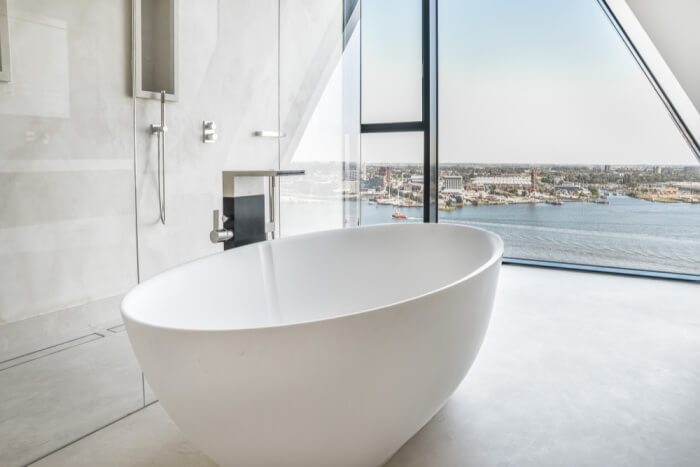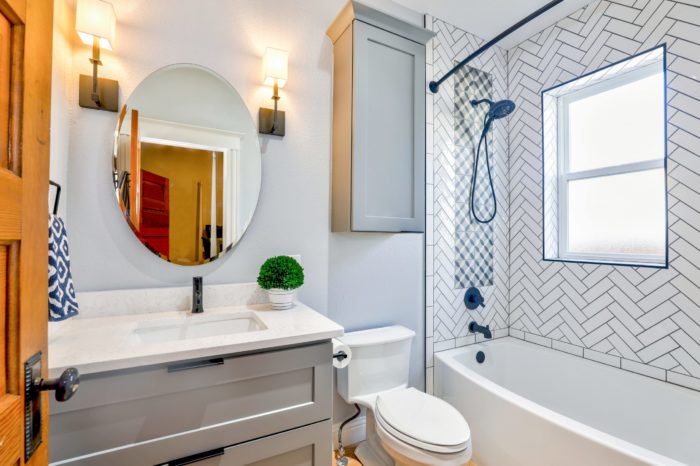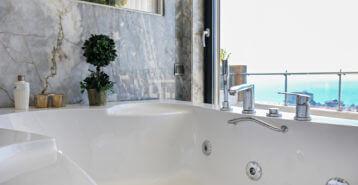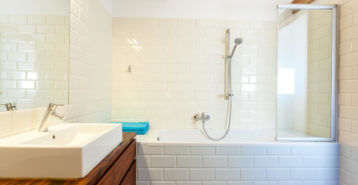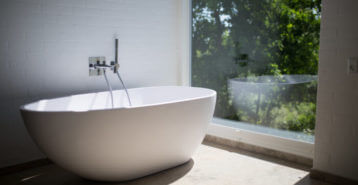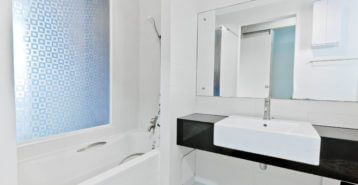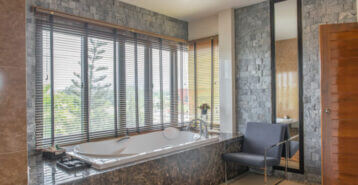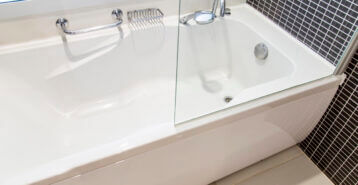What Is a Freestanding Tub?
As opposed to a built-in bathtub that is attached to your bathroom’s wall, such as an alcove tub or bathtub/shower combo, a freestanding bathtub stands alone. For that reason, these are also called “stand alone bathtubs.” Freestanding tubs are desirable for bathroom remodels today due to their unique appearance, versatile design options, and the element of relaxation they add to your space. Much to homeowners’ delight, they can often increase a home’s value. A freestanding tub can be a focal point that anchors the style of your bathroom in addition to giving you a spa-like retreat. If you are considering getting a new freestanding tub, explore this buying guide from Modernize to choose an ideal style and learn what to know about the installation process.
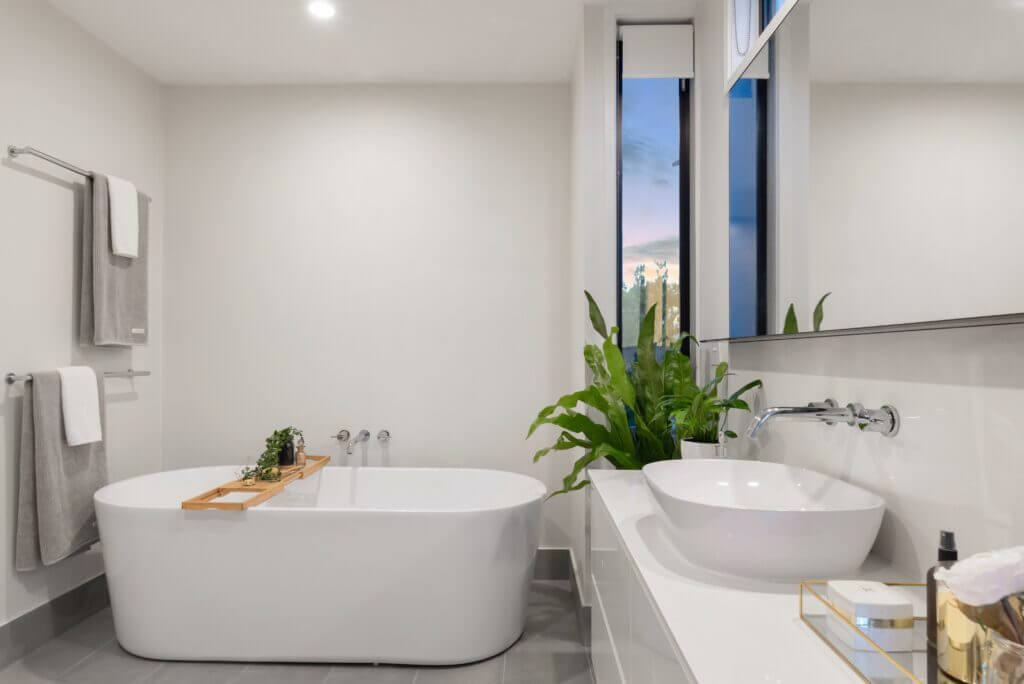
Is This Type of Tub Right for Your Bathroom?
In order to create that spa-like oasis that comes with a stand-alone tub, there are some practical considerations. Let’s take a look at the pros and cons of buying a freestanding tub.
-
Pros
- Takes up less space than a built-in tub
- Beautiful, unique look
- Can be deeper and longer than other tubs
-
Cons
- Tub weight may mean your floor needs reinforcements
- Can be an expensive purchase
- May require moving plumbing, which is costly
How Much Does a Freestanding Bathtub Cost?
A freestanding bathtub ranges in price depending on the material, size, and type you choose. Expect to pay between $3,656 and $4,100 for a new freestanding tub, including materials and installation.
The cost for a freestanding tub can vary tremendously. Different styles can cost more than others, and the tub’s material is usually very influential on the cost. For example, a basic acrylic single-ended freestanding tub can cost as low as $650, while a high-end clawfoot tub can cost $3,000 or more.
You can visit our bathtub replacement cost guide to learn about project costs.
How Do I Find the Best Price on Freestanding Bathtubs?
- Compare Models: Be sure to look at a few different bathtub models and styles and compare prices before choosing the best one for your bathroom. Shopping around and comparing multiple options can save you money during the installation.
- Purchase Open-Box Tubs: You can also sometimes find additional savings by purchasing a returned tub (also called an open-box tub) from a manufacturer.
- Choose the Right Time to Purchase: If you’re not in a hurry, also consider waiting until the off-season. Many homeowners choose not to remodel bathrooms in the fall and winter to avoid missing out on a hot bath when it’s cold. You may find that contractors offer better prices then than at other times of the year.
In addition to installation costs, it is also worthwhile to factor in things like return on investment and long-term savings opportunities to get the best overview of the cost of your freestanding tub.
Freestanding Bathtub Materials
Now that you’ve explored the different styles of tubs, it’s time to think about the material. Keep in mind that you can choose a material for the bathtub as well as the faucet and fixtures. Here are the most popular choices when it comes to freestanding tub materials.
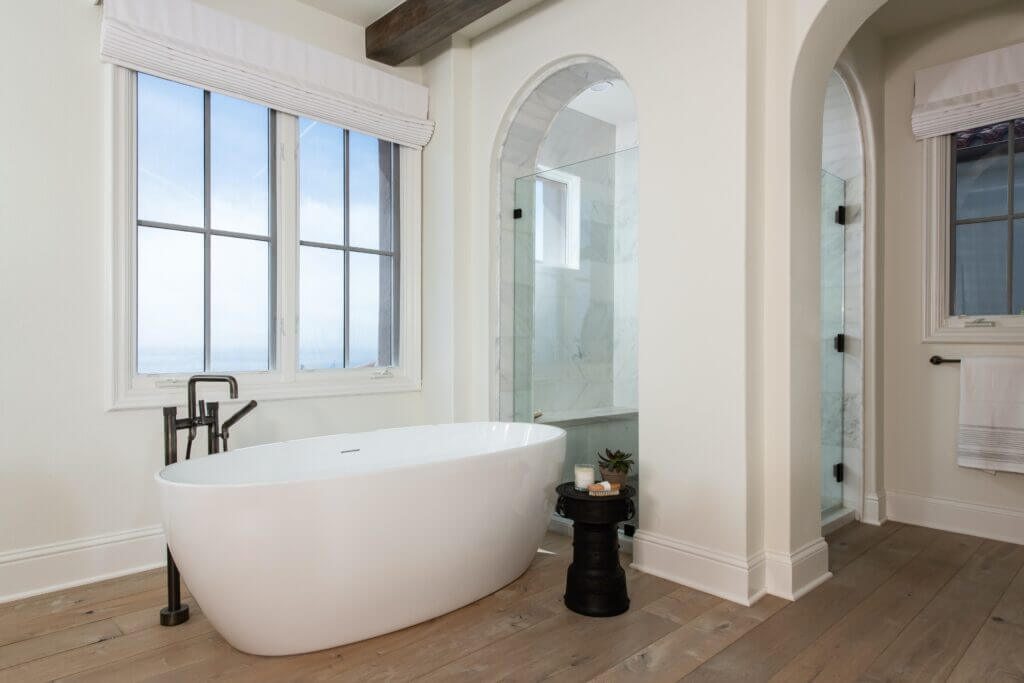
Acrylic
Acrylic is a popular tub material thanks to its lightweight nature. These tubs, even at a larger size, are easier to maneuver and install. Acrylic tubs are lightweight enough that most floors do not need reinforcing to handle the weight, even when placed in an upstairs bathroom. Acrylic freestanding tubs tend to have a lower cost, at just $700 to $1,100 on average.
Cast Iron
Just as acrylic is arguably the lightest material for a freestanding tub, cast iron is the heaviest. They are made of iron with a porcelain coating. This means they retain heat very well and stand up to scratches and dings. That durability comes at the cost of weight, however, making them more difficult to install and almost always requiring a strong reinforcement underneath the floor. The cost for a cast iron freestanding tub is moderate, at around $500 to $2,000 on average.
Resin
Also known as solid surface tubs, these usually have an integral drain and overflow system in the walls, as well as the ability to hide exposed piping. They are available in a gloss or matte finish, require little maintenance, but can be almost as heavy as a cast iron tub. These tubs can cost as much as $3,500 or more.
Copper
For a unique look, copper is a hand-crafted option that can be created in unique styles and shapes. Copper conducts heat almost as well as cast iron, helping to keep a steady temperature during a long soak. It is naturally resistant to mold and bacteria, easy to clean, and can be relatively lightweight, depending upon the style. Copper tubs are considered high-end, and their price tag can exceed $4,500 depending on the style.
Stainless Steel
This is almost always a quite modern looking tub, whether in a polished or brushed finish. This is a mid-weight tub that might not require reinforcement. It also requires very little maintenance, as stainless steel is naturally easy to clean. You can expect a stainless steel tub to cost around $1,500 to $2,500, but they can be more depending on the style.
Stone
These tubs, carved out of marble, granite, travertine, and other attractive stones, lend themselves well to custom work. They are extremely heavy, so reinforced floors are a must. Stone can create a focal point like no other material. It is also durable enough to last for decades. Stone has great heat retention, so you can enjoy long soaks. Keep in mind that these tubs will cost the most compared to other materials. Their price tag can fall around $5,000 or more.
Types of Stand Alone Bathtubs
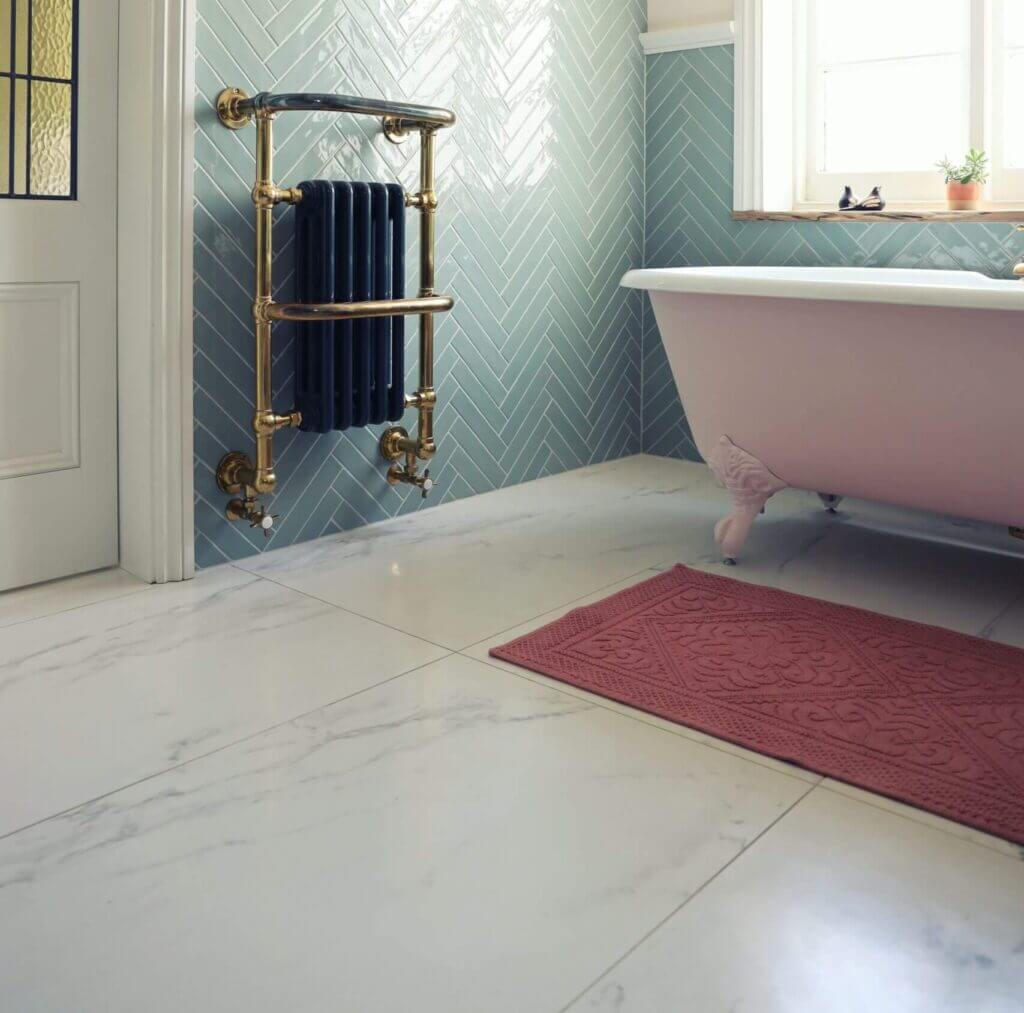
There are six main types of stand alone tubs to choose from.
- Single ended. This traditional tub has a drain at one end and a sloped edge at the other for relaxing bathing.
- Double ended. Perfect for two people, this variation has both ends sloped.
- Soaking. An especially deep freestanding tub. You can read more about them in our soaking tub cost guide.
- Japanese soaking tub. A smaller soaking tub that tends to be round.
- Pedestal. As the name implies, this skirted tub appears to be sitting on a pedestal.
- Clawfoot. This tub style was very popular in the 1800s and still looks at home in modern bathrooms today.
You can read more about types of freestanding tubs here.
Faucet Options
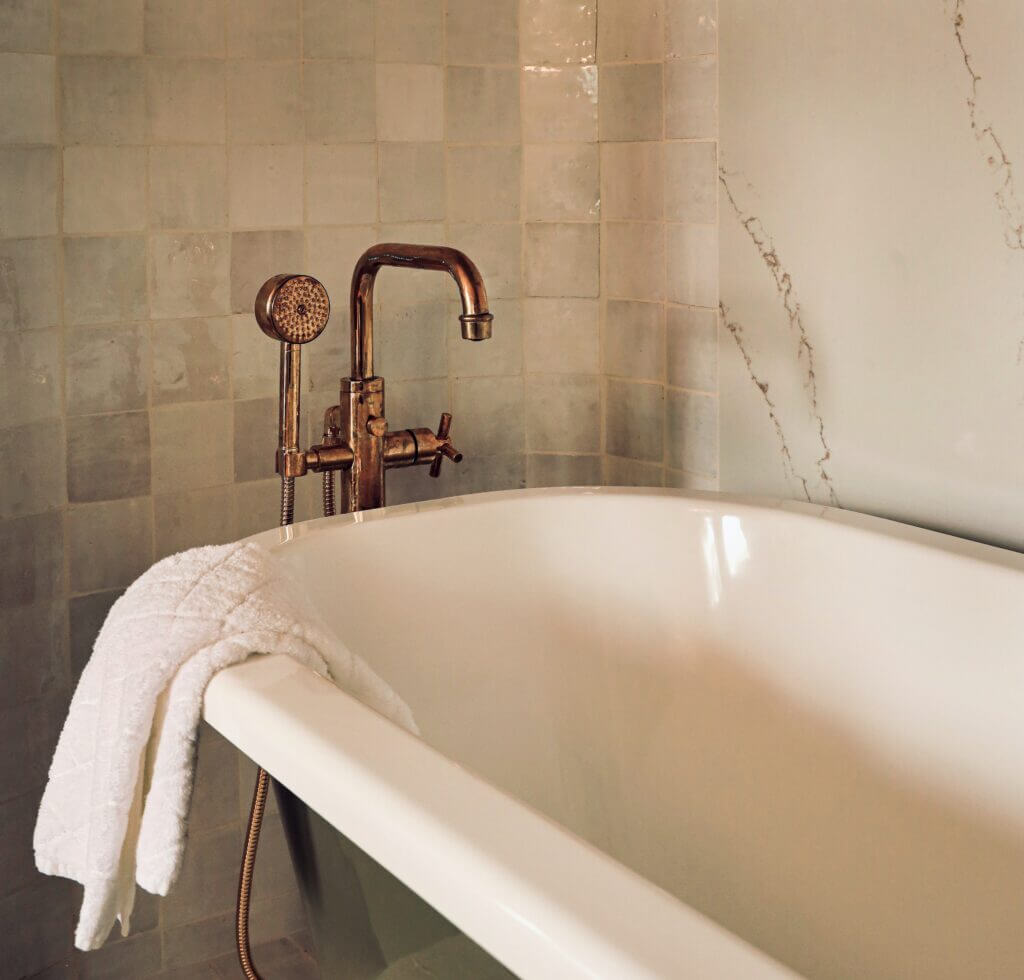
Unlike other bathtub types, a freestanding tub gives you a lot of freedom to consider where you want your faucet. The most popular options include:
- Wall mounted. As you’d expect, this faucet attaches to the bathroom wall.
- Tub wall mounted. Works very similarly to the above, but is mounted on the tub’s wall instead of the bathroom wall.
- Floor mounted. Installed on the floor just behind or next to your tub.
- Deck mounted. A faucet mounted on the tub’s rim.
- Roman. Installed on a platform surrounding the tub and built with hidden plumbing lines.
Here’s more information on freestanding tub faucet options.
Freestanding Tub Sizes and Dimensions
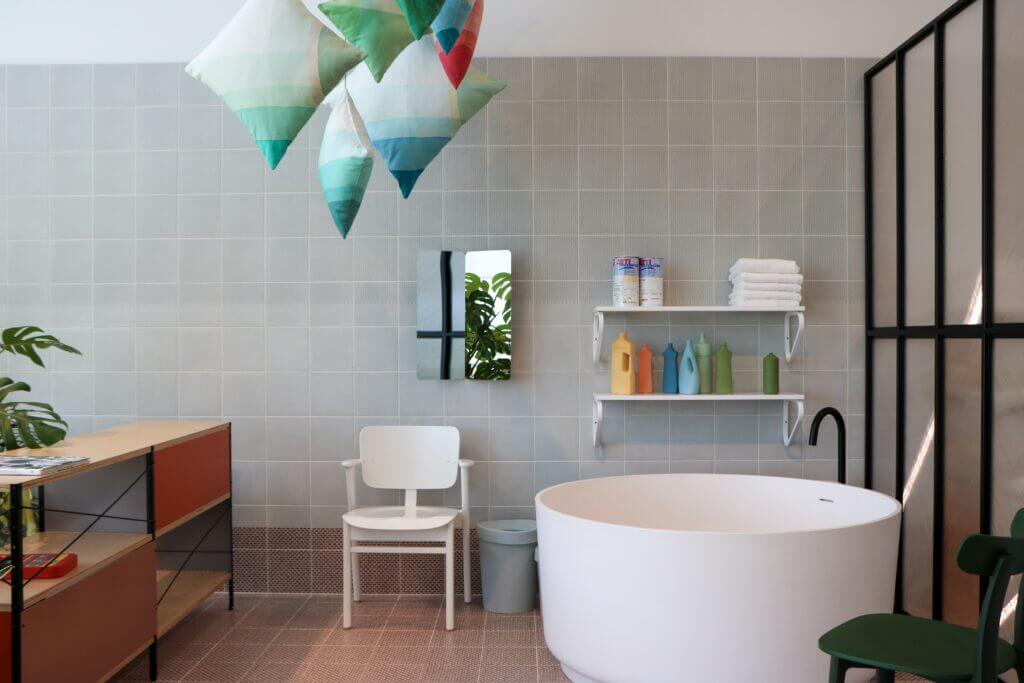
Before calling in the professionals to install your new freestanding bathtub, it’s important to understand freestanding tub sizes and know how much space is available in your bathroom.
Different types of freestanding tubs have different sizes and dimensions. It is certainly possible that not every tub will fit in your space. Below are the widths to expect for different types of freestanding tubs.
| Tub style | Average width |
|---|---|
| Single-ended | 48" to 70" |
| Double-ended | 55" to 72" |
| Single slipper | 43" to 73" |
| Double slipper | 43" to 73" |
| Pedestal tub | 52" to 78" |
| Clawfoot tub | 48" to 72" |
| Japanese soaking tub | 40" to 60" |
To see if a certain tub will fit, measure the space where you plan to install the bathtub, as well as the bathroom’s doorways. Make sure to leave at least 4 inches of space on all sides so you can safely enter and exit the bathtub. Also remember that the space you choose for your freestanding tub must have access to plumbing.
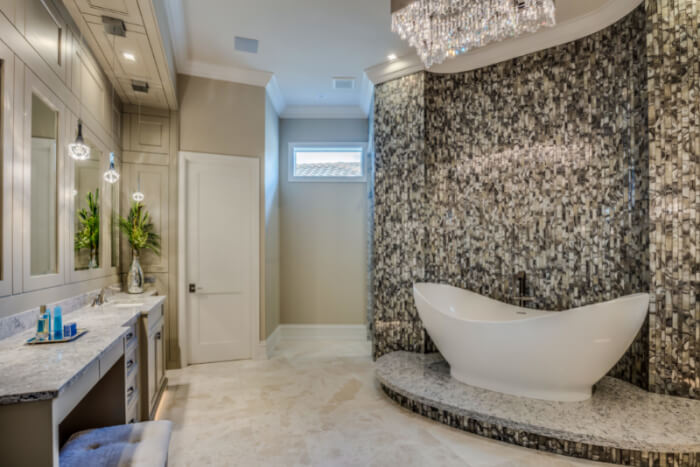
If you’re still deciding if a freestanding tub is right for you, here are some average dimensions you can use for a typical tub as well as for the smallest freestanding tub options and for especially large ones.
Average Freestanding Tub Dimensions
- Length: Approximately 55 to 72 inches (140 to 183 cm)
- Width: Around 27 to 32 inches (69 to 81 cm)
- Height: Typically 15 to 20 inches (38 to 51 cm)
Small Freestanding Tub
- Length: Typically shorter, around 48 to 55 inches (122 to 140 cm)
- Width: May be narrower, about 27 to 30 inches (69 to 76 cm)
- Height: Similar to average, around 15 to 20 inches (38 to 51 cm)
Large Freestanding Tub
- Length: Can be longer, from 72 inches or more (183 cm+)
- Width: Might be wider, around 32 inches or more (81 cm+)
- Height: Generally similar, around 15 to 20 inches (38 to 51 cm)
Next Steps for Your Freestanding Tub Project
Now that you know all about the costs, types, and sizes of freestanding tubs, here are a few next steps.
- Explore everything else there is to know about bathtubs by visiting our guide to tubs.
- Check out more information and cost must-knows in our bathroom remodeling guide.
- Find contractors near you who specialize in bathtubs by browsing our directory.
If you’d rather have Modernize do the work for you, we can match you with up to four vetted professionals so you can find the right contractor at the right price. Click the button below and answer a few questions about your project to meet your perfect pro.
Compare top-rated bathroom remodel pros in your area.
Read real homeowner reviews, explore qualifications, and view promotions. Modernize makes it easy to browse professionals and find one that will be perfect for your project.
